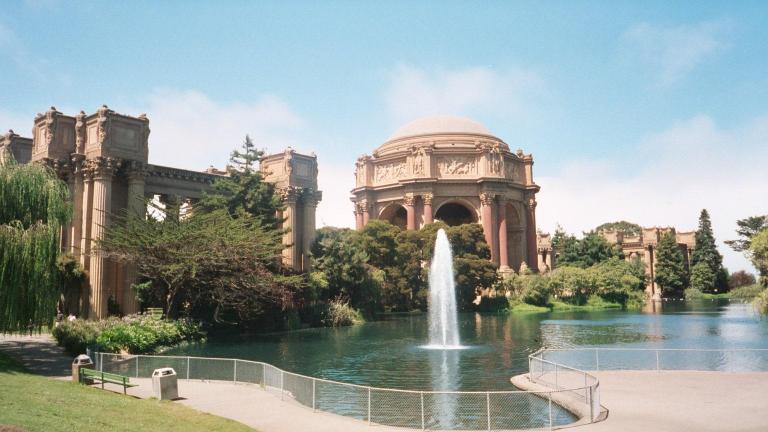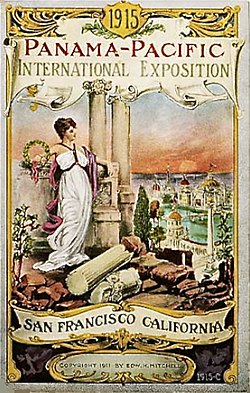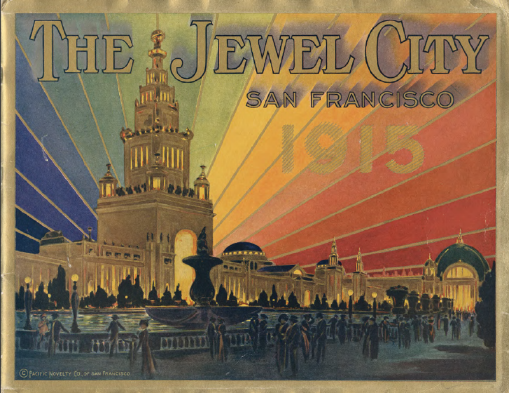|
Panama-Pacific Exposition 1915
By Cheryl Keyser
From February 20 to December 4, 1915, a major
international exposition stretched over six hundred acres along the
waterfront in San Francisco. The ostensible reason was to celebrate the
completion of the Panama Canal uniting two major oceans of the world for
the first time, but it also signified that San Francisco, which had been
so devastated by the 1906 earthquake was back and ready to do business.
 The
occasion was so momentous that the then California Governor Hiram
Johnson declared it a legal holiday. In Arlington, Va., across from the
Potomac River, President Woodrow Wilson pressed a golden telegraph key,
which not only triggered the doors of the various exhibit sites to open,
but also started the operations of the mechanical exhibits.
Unfortunately, opening day was not very conducive to festivities as the
weather - wet and blustery - was less than ideal for taking in all the
myriad exhibits, events, and entertainment. But that did not seem to
dissuade anyone from enjoying themselves. The
occasion was so momentous that the then California Governor Hiram
Johnson declared it a legal holiday. In Arlington, Va., across from the
Potomac River, President Woodrow Wilson pressed a golden telegraph key,
which not only triggered the doors of the various exhibit sites to open,
but also started the operations of the mechanical exhibits.
Unfortunately, opening day was not very conducive to festivities as the
weather - wet and blustery - was less than ideal for taking in all the
myriad exhibits, events, and entertainment. But that did not seem to
dissuade anyone from enjoying themselves.
World Fairs and Expositions have been around for
several centuries. Whether held in New York (the last one was
in 1964) or the 1904 St. Louis World's Fair, commemorated in the
movie "Meet Me In St. Louis" with its indelible music sung by
a young Judy Garland, these extravaganzas were filled with wonders to
come in the world from technology to culture. They were also family
affair with interests and activities to engage all family members.
The Panama-Pacific International Exposition (PPIE)
may not be so well-known today, but it still attracts its share of
collectors seeking all sorts of items. The many displayed on E-Bay
range in price from $1.00 for an unsent postcard to over $5,000 for a
"Medal Winner" vase. This was perhaps one of the largest
expositions with 44 states, 58 California counties, and 42 foreign
countries participating with a total of 80,000 exhibits.
 It
would be impossible in the space of this article to describe the whole
Exposition; it has been the subject of several books dedicated to
recounting its wonders. So we will follow the work of Christopher Klein
written for the History Channel. He developed a list of what he calls
the "Top Ten Draws." It
would be impossible in the space of this article to describe the whole
Exposition; it has been the subject of several books dedicated to
recounting its wonders. So we will follow the work of Christopher Klein
written for the History Channel. He developed a list of what he calls
the "Top Ten Draws."
Heading Kleinís list is the Ford Assembly
Line. It seems odd to think this was a major event, but we have to
remember, the automobile industry was then in its infancy and people
were thrilled to see how this machine worked. For three hours daily, a
car rolled off the assembly line and was then sold to a local dealer.
Flying was also a new experience. Most people had
probably never see a real plane, much less ridden in one. The Lockheed
Brothers took visitors on a 10-minute flight on a hydroplane over San
Francisco Bay while Art Smith did aerobatic stunts on his hand-built
bi-plane.
The first transcontinental phone call was placed by
Alexander Graham Bell when he spoke to the west coast. Attendees at the
event could use a receiver installed at their seats to hear that first
long-distance conversation and could even place one themselves.
To continue the theme of the Exposition, a 5-acre
model of the Panama Canal was built at a cost of $500,000. The 23-minute
ride on an elevated track, accompanied by Edison's voice describing the
site, was another big visitor attraction.
A major highlight of the Exposition was the 43-story
stepped Tower of Jewels. Located near the Exposition entrance, it was
then the tallest structure in San Francisco. The "jewels" were
100,000 polished Austrian crystals and colored glass, which glowed in
the sun and shimmered with floodlights during the night lighting up the
entire Exposition.
A rather strange exhibit was the recreation of an
historic deluge that occurred in Dayton, Ohio in 1913. Not only was it
an odd element in a celebratory event, but it also featured a giant
trying single-handedly to hold back the water.
Another curious exhibit was the two-story ascent of a
passenger car located at the end of a steel arm. The 10-minute ride gave
a dramatic view of the Exposition from the height of 235 feet.
And then there was the typewriter - rather the
15-foot-high typewriter. It was so large than an individual could sit on
the keys - and it worked using a 100-foot-long ribbon.
 The
Palace of Fine Arts featured more than 11,000 items of paintings,
sculptures, and other types of art in a 162-foot-high rotunda with
artists from the United States and countries in Europe and Latin America
represented. Not only were they noted artists, such as James McNeill
Whistler and Winslow Homer, but also those more humble, as the
sculptress Emily Clayton Bishop, from the small town of Smithsburg,
Maryland whose work was presented posthumously by her two best friends. The
Palace of Fine Arts featured more than 11,000 items of paintings,
sculptures, and other types of art in a 162-foot-high rotunda with
artists from the United States and countries in Europe and Latin America
represented. Not only were they noted artists, such as James McNeill
Whistler and Winslow Homer, but also those more humble, as the
sculptress Emily Clayton Bishop, from the small town of Smithsburg,
Maryland whose work was presented posthumously by her two best friends.
After the Exposition closed, this Palace was torn
down and rebuilt in 1960. It is the only Exposition building still on
its original site.
And then there was Stella. This large painting of a
nude woman was so designed that she seemed to breathe. She drew such a
crowd that the 2-minute look, at the cost of a dime, brought in $75,000.
Hailed as a resounding success in its day, the
Panama-Pacific Exposition of 1915 and its artifacts evoke a simpler
past, and for those who are motivated to collect its historic items it
represents an area still to be mined.
DID YOU KNOW?
While World Fairs and Expositions do not seem to
attract visitors today in our interconnected world, they still continue.
They are held approximately every 5 years, with the next scheduled to be
held in 2020 in Dubai. To be considered an official "Expo," it
must be sanctioned by the Bureau of International Expositions in
Paris.
PHOTOS (top to bottom)
Modern day photo of reconstructed Palace of Fine Arts
Panama pacific poster
The Jewel City Souvenir booklet
|